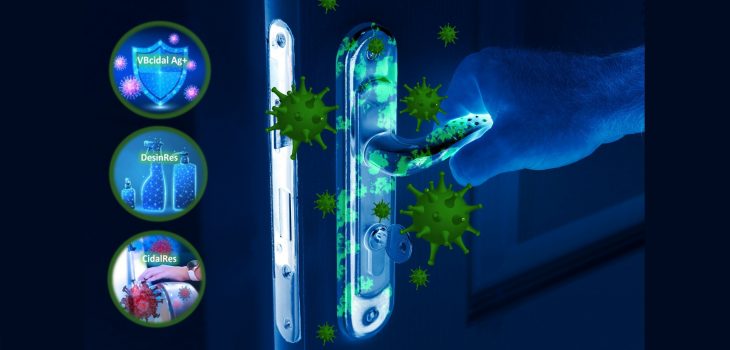The use of antibacterial and antiviral varnishes and coatings in construction


The matters of protection of people and their environment against viruses and bacteria have become a burning issue nowadays. Human communities try to maintain social distancing, governments fight with viruses by introducing restrictions and regulations in order to limit their spread. Negative impact of the pandemic affect global economy as well as human health and our social life. Individually and collectively, we strive to protect ourselves from diseases transmitted by viruses and bacteria and their paralysing effect on the economy worldwide.
Human being, thanks to their carelessness, has significantly raised the risk of spreading dangerous and never-before-known viruses and bacteria and diseased caused by them. Doctors have been alarming societies and governments of their countries about increasing antibiotic-resistance of bacteria being used in medical treatment of humans for years. In the wake of more and more realised post-covid and post-antibiotic era, means of direct combat of viruses and bacteria on surfaces in contact with human body are gaining even bigger significance.
In order to meet these important and pressing social needs, SPLinx has introduced to its portfolio a wide range of varnishes and coatings (antibacterial and antiviral), offered in two basic groups of coatings:
– containing pigments-carriers of silver ions, and
– coatings with added active nano ingredients which degrade viruses, bacteria, pathogens, moulds and fungi.
In the first option, silver ions show high efficiency of fighting off viruses and bacteria. Silver, called a killer of viruses and bacteria, has been successfully used for years for production of products meant to combat these microbes, so dangerous for humans.
In our varnishes, glass pigments are carriers of silver ions. This inorganic material is characterised by a very high resistance to high temperatures, non-volatility and is safe and gentle for the human body. One of properties of glass is its ability to keep biocidal metals as ions. In the presence of water or moisture, glass gradually releases silver ions, acting as a bactericidal and virucidal material.
The biggest advantage of these products is their bactericidal and virucidal activity, confirmed at the level of 99%. Virucidal paint by SPLinx can be applied on a stable layer of old paint, and thus, a resistant and virucidal coating is obtained. Biocidal coatings by SPLinx come in transparent and coloured versions.
We have a few biocidal solutions in our offer, from the antiviral and antibacterial wall coating itself to complete microbicidal wall paint systems, which often consist of three products and have resistance to mechanical wear and, primarily, to the most popular disinfectants.
In the second option, microbicidal coatings are based on nano-sized additives, which excellently absorb and destroy all the organic substances, including microorganisms such as viruses, bacteria, mould, fungi etc. It is possible to add nanoplates with nanotubes to a curently existing combination of nano ingredients which will increase the biological activity of the components and thus, result in even stronger biocidal effect.
The nanostructures filling our biocidal coatings have almose an electrifying effect, they destroy all the harmful microorganisms in an extremely effective and immediate way. Their additional yet very important feature is exceptionally easy application, because they can be very easily sprayed onto surfaces we would like to protect. Nano-sized particles do not need a layer of a coating which has adhesive properties to the substrate, just as it is in case of traditional inks, paints and varnishes. Their size guarantees absorbtion and merging into a single structure with a coated surface. Nanoparticles, after such application, become a part of a coated material.
Microbicidal coatings can be used generally wherever there is a possibility of transfer of harmful microbes to the human organism. Primarily, they can be used as coatings on walls, floors and other surfaces in public buildings, especially in healthcare facilities.
Paints and varnishes with silver ions can be applied traditionally, by using roller or a spray painting gun. Just a small amount the product is enough to provide a microbicidal effect. The alternative to this solution is the use of biocidal nano substances, which can be sprayed (fogged) in a room we would like to protect. Particles of microbicidal nanostructures will penetrate into each surface they reach, creating a protective barrier which destroys any viruses, bacteria, moulds and fungi.
This way, we can protect all kinds of printed surfaces, buildings, installations, elements of our surroundings not only against dangerous effects but also from the transmission and spread of dangerous diseases and infections.
It is important to note in this topic that microbicidal coatings work sort of in the background, completely not interfering with any visual aspects of spaces protected this way. The coatings are completely transparent, odourless and neutral for human health and thus they do not change a character and the appearance of coated surfaces in any way. Undistrubed message and idea are in this case supported by guarantees of safety for human health and life.
You can find the original article here:
https://www.architekturaibiznes.pl/antybakteryjne-antywirusowe-powloki-lakiernicze,6914.html



